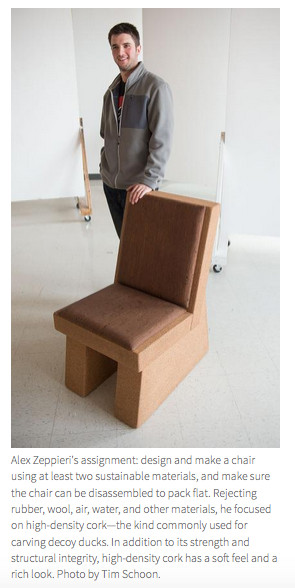Engineering major develops sustainable furniture from cork...and it's comfy
By Matt Jansen and Gary Galluzzo
University of Iowa Strategic Communications
It isn’t every day that you read about a college student who sets out to design and construct environmentally sustainable furniture.
So, how did it happen to Alex

“It was a happy mistake,” he says, adding that a fall 2014 course he had intended to take was canceled, and he enrolled in a course called “Environmental Design 1” as a substitute.
Only after the course had begun did he learn that a chair was to be designed and built by the end of the fall semester. The course also required that the chair must be constructed of at least two sustainable materials, be able to be assembled and disassembled to "pack flat," and be made of components cut using computer numerical control (CNC) technology, in which a computer program directs the cutting machinery.
Selecting a sustainable material became Zeppieri’s first objective. Rejecting rubber, wool, air, water, and other materials, he focused on high-density cork—the kind commonly used for carving decoy ducks. In addition to its strength and structural integrity, high-density cork has a soft feel and a rich look—and it’s sustainable.
Zeppieri says he believes there are common-sense advantages to sustainable furniture.
“Besides being a requirement for the class,” he says, “I believe that our communities, locally and nationally, are always looking to develop better, environmentally friendly designs. Whether these designs are for buildings, furniture, or household products, designers are now, more than ever, implementing the idea of using recycled and sustainable materials. I see it as our way of using minimal resources as well as protecting our environment.
“The (cork) business is environmentally friendly; the trees will produce more cork,” he says.
The steps involved in making cork furniture are straightforward, but time-consuming.
They include sketching and finalizing a design, constructing scale models, locating a cork vendor, ordering materials, hardening the cork by treating it with polyurethane, cutting it with a high-pressure water-jet machine, assembling the components, and covering the product—in the case of a chair—with a cork-based cloth fabric.
For the spring 2015 semester of the design course, he is designing a coffee table.
Monica Correia, associate professor of art and art history, says that in teaching the course for some five or six years, she has always required students to first produce a chair, followed by a coffee table or other item.
“It’s always a chair first,” she says. “Every office has a chair as an icon. My students have to investigate ergonomics and aesthetics at the same time. It helps them to understand the relationship between an object and the human body, as well as how to assemble objects. They have to figure it out on their own."
She notes that many of her design students have been engineers, some of whom have gone on to study architecture—and virtually all of these have gone on to study at prestigious architectural schools.

“Furniture Design has taught me an abundance of principles and skills that I can transfer over to a civil engineering position,” he says. “Through Furniture Design, I have learned how to fully use 3D modeling software.
“The courses have also taught me how to properly schedule and communicate with other parties to accommodate a functional, sustainable design. It was very exciting to see a simple design and idea turn into something that was functional and sustainable.
“Through engineering and art at the University of Iowa, I was successfully able to produce a ‘One-of-a-Kind Cork Chair.’ Since I have a strong passion for art and 3D-design, it was very satisfying to create a product and watch it change throughout the design and construction phases.
“Even if I don't pursue furniture design in the future, I am thankful that I took these courses because they allowed me to express my creativity through product design. I hope others can eventually see the products that are produced by the 3D design studio so they too can be inspired to share their creativity within their own work,” he says.
To watch the video, go to https://www.youtube.com/watch?feature=player_embedded&v=b3e_9tfmU7Q.